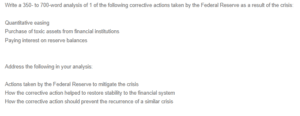The Banking Industry Crisis – Quantitative Easing
Quantitative easing (QE) refers to a monetary policy whereby the Federal Reserve (FED) purchases long-term securities from the open market to increase money circulation in the economy and boost investment. For instance, in response to the COVID-19 pandemic, the Federal Reserve reduced interest rates to zero and started asset purchases. Since mid-2020, the Federal Reserve has been buying $40 billion of treasury securities and $40 billion of mortgage securities (Wessel, 2021). Our assignment writing services will allow you to attend to more important tasks as our experts handle your task.
Impact
By purchasing long-term securities, the federal bank effectively changes the securities’ interest rates and the interest rates of other financial instruments, such as corporate bonds. The purchases ought to be on a large scale to ensure an appreciable value in the interest rates. For instance, when FED purchases treasury securities, their demand increases, thus raising their price (Wessel, 2021). Consequently, the interest rates of the treasury securities fall since price and interest rates have an inverse relationship. Low interest rates mean that the cost of financing capital investment is low. QE, therefore, bolsters capital investment, creating more jobs and ensuring economic growth.
There are concerns that QE actions may lead to inflation. Banks currently hold the highest junk of monetary reserves. If banks loan the reserves to the public, the monetary base increases, leading to inflation (Ugai, 2007). However, that is not always the case since other policies limit the impact of QE. For instance, payment of interest rates on reserves incentivizes banks to retain more balances at the federal reserves instead of loaning all it.
QE helps the economy during a crisis by reducing the cost of business and mortgage loans. The action signals good intentions and a plan by the Federal Reserve to support the economy (Benford et al., 2009). QE is the last resort solution after dropping interest rates to zero does not bring the desired effect.
Prevention of Future Crisis
To prevent future financial recessions from turning into depressions, the Federal Reserve ought to utilize QE. The tool proved to be helpful to the economy during the great recession, and it can help avert future financial crises. However, there is a need to balance QE and other reverse monetary policy tools to avoid inflation. Balancing these tools will influence the pricing behavior in the public’s interest.
References
Benford, J., Berry, S., Nikolov, K., Young, C., & Robson, M. (2009). Quantitative easing. Bank of England. Quarterly Bulletin, 49(2), 90.
Ugai, H. (2007). Effects of the quantitative easing policy: A survey of empirical analyses. Monetary and economic studies-Bank of Japan, 25(1), 1.
Wessel, E. M., Tyler Powell, and David. (2021, July 15). What does the Federal Reserve mean when it talks about tapering? Brookings. https://www.brookings.edu/blog/up-front/2021/07/15/what-does-the-federal-reserve-mean-when-it-talks-about-tapering/
ORDER A PLAGIARISM-FREE PAPER HERE
We’ll write everything from scratch
Question

Quantitative Easing
Write a 350- to 700-word analysis of 1 of the following corrective actions taken by the Federal Reserve as a result of the crisis:
Quantitative easing
Purchase of toxic assets from financial institutions
Paying interest on reserve balances
Address the following in your analysis:
Actions taken by the Federal Reserve to mitigate the crisis
How the corrective action helped to restore stability to the financial system
How the corrective action should prevent the recurrence of a similar crisis

